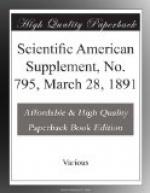At first sight it seems a dangerous experiment to mix a heavy hydrocarbon gas with oxygen, but it must be remembered that although hydrogen and carbon monoxide only need to be mixed with half their own volume of oxygen to give a most explosive mixture, yet as the number of carbon and hydrogen atoms in the combustible gas increase, so does the amount of oxygen needed to give explosion. Thus coal gas needs rather more than its own volume, and ethylene three times its volume, to give the maximum explosive results, while these mixtures begin to be explosive when 10 per cent. of oxygen is mixed with hydrogen or water gas, 30 per cent. with coal gas, and over 50 per cent. of oil gas of the character used. It is claimed that if this gas was used as an enricher of coal gas, 5 per cent. of it would increase the luminosity of 16-candle gas by about 40 per cent.
Oxygen has been obtained for some time past from the air on a commercial scale by the Brin process, and at the present time there seems every prospect of our being able to obtain oxygen at a rate of about 3s. 6d. per 1,000 cubic feet. Another process by which this important result can also be obtained was first introduced by Tessie du Mothay, and has now just been revived. It consists of passing alternate currents of steam and air over sodic manganate heated to dull redness in an iron tube; the process has never been commercially successful, for the reason that the contents of the tube fused, and flowing over the surface of the iron rapidly destroyed the tubes or retorts, and also as soon as fusion took place, the mass became so dense that it had little or no action on the air passing over it. Now, however, this difficulty has been partly overcome by so preparing the manganate as to prevent fusion, and to keep it in a spongy state, which gives very high results, and the substance being practically everlasting, the cost of production is extremely low.
It is proposed to feed this by a separate system of pipes to small gas jets, and by converting them into practically oxyhydrogen blow pipes, to raise solid masses of refractory material to incandescence, and also by supplying oxygen in the same way to oil lamps of particular construction, to obtain a very great increase in illuminating power.
Whether these methods of employing cheap oxygen would be successful or not, I do not wish to discuss at the present time, but there is no doubt but that cheap oxygen would be an enormous boon to the gas manager, as by mixing 0.8 per cent. of oxygen with his coal gas before purification, he could not only utilize the method so successfully introduced by Mr. Valon at Ramsgate, but could also increase the illuminating value of his gas.
In speaking of the structure of flame, I pointed out that close to the burner from which the gas giving the flame is issuing, a space exists in which no combustion is going on—in other words, a flame is never in contact with the rim of the burner. This is best seen when the gas is turned low—with a batswing burner, for instance—turned so low that only a small non-luminous flame is left, the space between burner and flame will appear as great as the flame itself, while, if the gas is mixed with an inert diluent like carbon dioxide, the space can be very much increased.




